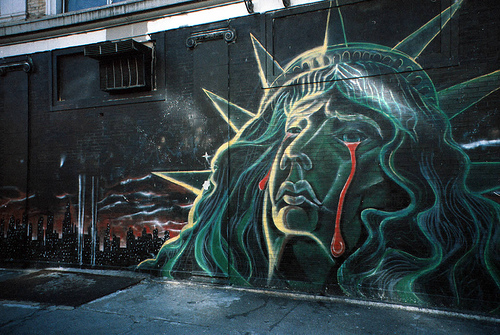It should be no surprise that inner cities will become in-vogue, as baby-boomers seek to understand the world, themselves, and their mistakes in community and economic planning. It has become an age of building legacies which can often be haunted by urban decay, homelessness and poverty.
Inner cities are now taping into travel markets by providing socially consious travellers with a chance to explore the real inner city, complete with the homeless, poverty and crime. All this is packaged as educational adventures, but what are the key attractions?
Answer: architecture, personalities and graffiti.
This makes any real estate developer or politician cringe for sure. Imagine showcasing urban decay and encouraging the defacing of private property.
Something like graffiti and the grafiiti artist could be a metaphor within all of this. We are in the midst of a travel revolution, one that’s presenting us with cultural experiences that challenge our view of the world around us.
Historically, the term graffiti referred to the inscriptions and figure drawings found on the walls of ancient ruins, as in the Catacombs of Rome or at Pompeii, and is largely used in art history to refer to works of art made by scratching the design on a surface.
Go back even farther when ancient man took the charcoal from his fire and drew crude scenes on cave walls. Today, those primitive descriptions of our early ancestors and their environment are roped off and protected; archeologists come from miles around to ponder the pictographs and try to determine what they indicate about the individuals that left them behind.
Sure some graffiti, maybe most of it, is mindless vandalism, with no philosophical character attached, but how do we know for sure? Depending on the intention of the artist, when and where graffiti is created and encountered, the markings can be regarded variously as art, resistance, threat, a joke, advertising, political or social commentary or interpretations far beyond the scope of mainstream culture.
Graffiti tours are beginning to surface in a number of community’s worldwide, to the shock of many. Anti-graffiti campaigners warn the tours will spark a flurry of fresh vandalism because those who do it crave exposure of their work.
There’s no question that defacing public and private property strikes at the integrity of fairness and should be a violation. However, from the perspective of adventure hungry globetrotters seeking the edge of learning, the idea of viewing the latest sensational “tag” might be as tempting as storm-watching or capturing a view of a grizzly bear in the wild, or some rare and endangered species.
In Melbourne, Australia, tourists in groups of up to 15 are likely to be charged about $40 each for a tour with Hidden Secrets Tours. The tour evolved after seeing visitors' reaction to street graffiti on the company's Lanes and Arcades Tour. The tour now includes yet a new evolution of art: “Commissioned Graffiti” an art form that now bridges anarchy with conformity more acceptable to property owners and politicians.
Then there’s the Toyshop Collective in New York City which gives free street art and graffiti tours throughout the city, most recently as a bike tour. This group confronts urban alienation and private ownership with a takeover of public space, events and performances aimed at redrawing physical and psychological landscapes. They claim their gallery is on the streets, and they want to share it with visitors.
Their tours point out famous and hidden spots throughout the city and includes the Graffiti Hall of Fame in East Harlem. The tour also includes Brooklyn and other New York City highlights, history and the social implications of street art ending with a surprise evening performance and party.
It will be interesting where the art historians land on this one. The argument whether graffiti is art or vandalism has been going on for quite sometime, but it appears as though the graffiti artists are winning this one, at the dismay of the high browed critics, who don’t care much for tattoos or needle point folk art either, and call log houses a primitive form of non-sustainable architecture.
But they have been wrong before, if there is such a thing as being wrong.
Travel is all about exploring differences, so that we can grow and become renewed in some way. Travelers love to witness and connect first hand with the expression of an idea, and that should be the message to any community trying to attract tourists.
The courage to break out of conformity is what garners respect. One can’t help but think that we might see the future staring at us, but in our need to relish in the safety of conformity, we’d much rather look at the emptiness of a fresh coat of paint and a cover-up.
And then of course there’s those of us who say, that all of this is in fact an over-reaction, let them spray bomb, as long as it’s not on my wall.
Graffiti is in fact a constant reminder that a sub-culture exists in a community, people who think differently and cannot be completely controlled by the mainstream culture, no matter how hard it tries. It should also remind us that there’s much to be learned about ourselves, cultural differences and our future, right in our own backyard, or back alleys.
I like the words of famous NYC graffiti artist Zephyr when he passes advice to other grafitti artists, “ Don’t get arrested and don’t get killed. Respect yourself. Respect others”.
(30)

